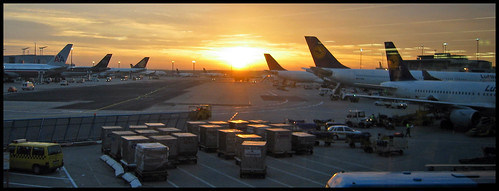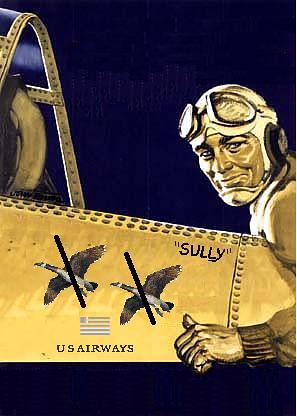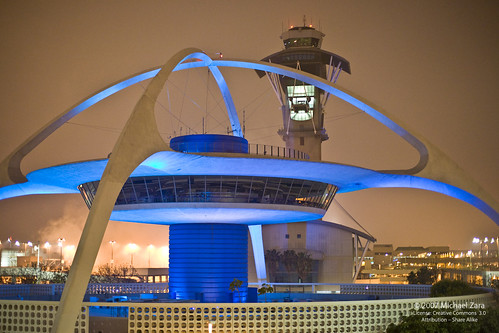Take that, all you tardy aviators! USDOT slams precedent-setting fines on three airlines responsible for tarmac delays
(Source: NPR)
The government is imposing fines for the first time against airlines for stranding passengers on an airport tarmac, the Department of Transportation said Tuesday.
The department said it has levied a precedent-setting $175,000 in fines against three airlines for their role in the stranding of passengers overnight in a plane at Rochester, Minn., on Aug. 8.
For those unaware of the issue, here is a wonderful write-up , courtesy of Wall Street Journal Blog, that gives you a good understanding of the incident that prompted this Fed action and a breakdown of the DOT penalties for each of the involved parties.
Flight 2816 from Houston to Minneapolis was diverted to Rochester at 12:30 a.m. and passengers were held onboard until 6:15 a.m., when they were finally allowed into a terminal, DOT said. ExpressJet, which operated the flight on behalf of Continental, had contacted Mesaba, the only airline with ground handling at Rochester, before the plane landed. Mesaba agreed to provide ground services. But shortly after the flight arrived, a Mesaba employee told the flight’s captain passengers couldn’t deplane because there were no Transportation Security Administration screeners on duty. That didn’t matter—TSA rules don’t prohibit people from deplaning without screeners on duty.
DOT fined Continental and ExpressJet $100,000 for engaging in unfair and deceptive trade practices because they violated Continental’s customer service commitment, which promises that passengers will be allowed off a plane after it has been sitting for three hours. Mesaba was fined $75,000 for an unfair and deceptive practice when it provided inaccurate information to ExpressJet about deplaning passengers from Flight 2816, the DOT said.
Continental and ExpressJet, which each were fined $50,000, both said in statements that they agreed to the DOT’s consent order to avoid costly litigation. They both noted that ExpressJet had worked throughout the night to deplane passengers but was blocked by Mesaba. Mesaba said in a statement it believes it “operated in good faith by providing voluntary ground handling assistance to ExpressJet,’’ but is re-evaluating policies and procedures because of the event.
Secretary LaHood followed-up on this issue with a blog post, expressing his support for the passengers: “Look, this is just no way to treat passengers, customers, or anyone. You can’t strand people overnight without access to the basics. It’s not right; it’s against the rules.”
Click here to read the entire article.
Transportgooru Musings: Thank you, Secratary LaHood. Your actions reaffirm that our Government is indeed “for the people, by the people, of the people.” Interesting enough, the NPR story also notes that the department’s action comes at a time when the Congress is weighing legislation that places a three-hour cap on how long airlines can keep passengers waiting on tarmacs before they have to offer them the opportunity to deplane or return to a gate. The measure would give a flight’s captain the authority to extend the wait an additional half hour if it appears that clearance to takeoff is near. As one would expect, the Air Transport Association (ATA), which represents major airlines, is opposing this measure. According to the ATA, a three-hour limit could create more problems than it alleviates by increasing the number of flights that are canceled and leaving passengers stuck at airports trying to make new travel arrangements.
How is that the European airlines are able to successfully operate without encountering such problems? I’ve not seen anyone from an European airline complaining about the EU regulations (at least after it had become a law). The European Union, which caps the acceptable delay at 2 hrs, has successfully enacted the Passenger Bill of Rights that has some reasonable points that tells you how much they care about a passenger stuck in a metal tube with no access to basic necessities such as food. The following summary of the EU law, courtesy of Airsafe.com, gives you a good idea of what the European value system looks like:
Delays and Cancellations for European Union Related Flights
In most, but not all, cases involving a delay or cancellation of a flight, a passenger is entitled to compensation under European Parliament Regulation (EC) 261/2004 for delayed and cancelled flights. There are three levels of compensation:
- in the event of long delays (two hours or more, depending on the distance of the flight), passengers must in every case be offered free meals and refreshments plus two free telephone calls, telex or fax messages, or emails;
- if the time of departure is deferred until the next day, passengers must also be offered hotel accommodation and transport between the airport and the place of accommodation;
- when the delay is five hours or longer, passengers may opt for reimbursement of the full cost of the ticket together with, when relevant, a return flight to the first point of departure.
This regulation applies to all airline flights departing from an EU airport or to any airline licensed in the EU if that flight is departing from an airport outside the EU to a destination at an airport in an EU member state.
Delays and Cancellations for Other International Flights
While the EU has some regulations that specifically deal with EU related international flights, there are no requirements to compensate passengers on most other international flights that are delayed or cancelled.
The most relevant international treaty is the 1999 Montreal Convention, an international agreement signed by the U.S. and many other countries. There is no specific language in this agreement that obligates the airline to compensate passengers in the event of a flight delay or flight cancellation. As would be the case with domestic U.S. flights, review your airline’s policies to see what compensation, if any, that the airline may provide.
Overbooking and Involuntary Bumping on U.S. Airlines
U.S. airlines are allowed to overbook flights to allow for “no-show” passengers. However, if passengers are involuntarily bumped, airlines are required to do ask for volunteers to give up their seats in exchange for compensation. Most involuntarily bumped passengers are subject to the following minimum compensation schedule:
- There is no compensation if alternative transportation gets the passenger to the destination within one hour of the original scheduled arrival.
- The equivalent of the passenger’s one way fare up to a maximum of $400 for substitute domestic flights that arrive between one and two hours after the original scheduled arrival time or for substitute international flights that arrive between one and four hours after the original scheduled arrival time.
- If the substitute transportation is scheduled to get you to your destination more than two hours later (four hours internationally), or if the airline does not make any substitute travel arrangements for you, the compensation doubles to a maximum of $800.
There are exceptions to these rules. This minimum compensation schedule does not apply to charter flights, to scheduled flights operated with planes that hold 30 or fewer passengers, or to international flights inbound to the United States. If a passenger can’t be accommodated to their satisfaction, they may be eligible to request a refund for the remaining part of the trip, even if the trip were on an otherwise nonrefundable ticket.
Denied Boarding Compensation in the European Community
If you are bumped from a flight and your flight was either departing from an EU country, or if you were on an airline registered in the EU and your flight departed outside the EU for a destination within the EU, you would have the following rights:
- Reimbursement of the cost of the ticket within seven days or a return flight to the first point of departure or re-routing to the final destination;.
- Refreshments, meals, hotel accommodation, transport between the airport and place of accommodation, two free telephone calls, telex or fax messages, or emails;
- Compensation totalling:
- – 250 euros for all flights of 1,500 kilometers or less;
- – 400 euros for all flights within the European Community of more than 1,500 kilometers, and for all other flights between 1,500 and 3,500 kilometers;
- – 600 euros for all other flights.
Note that in April 2008, the exchange rate was about $1.60 per euro.
Compensation for Downgrading in Service in the European Community
f an air carrier places a passenger in a class lower than that for which the ticket was purchased, the passenger must be reimbursed within seven days, as follows:
- 30% of the price of the ticket for all flights of 1500 kilometers or less.
- 50% of the price of the ticket for all intra-Community flights of more than 1500 kilometers, except flights between the European Community member states and the French overseas departments, and for all other flights between 1500 and 3500 kilometers.
- 75% of the price of the ticket for all other flights, including flights between the European Community member states and the French overseas departments.
If you buy a car, it comes with a warranty, plus the chances are your state has an auto lemon law, and there are various federal safety and other standards the car must also meet. If anything is not as advertised and promised, you have recourse.
But if you buy a first class airline ticket, costing $10,000 or more – as much as a small car – you have almost no rights at all, not even a guarantee that you’ll get a full first class experience.
If you buy a loaf of bread and it is stale, you can return it. The supermarket will be apologetic, won’t demand proof the bread is stale, and will either fully refund you the cost or give you a new loaf of bread in exchange. But if your seat is broken on a long flight, or if the airline doesn’t have your first choice of meal, or if anything else goes wrong with your flight experience, you’re unlikely to get a sympathetic hearing or fair compensation.
And if you complain about poor service, you run the risk of being accused of ‘air rage’, of being arrested, and possibly being banned from that airline for life.
We need an Airline Passenger Bill of Rights.
Now, after reading the EU regulation you might be left wondering why are our law makers still debating about this. Don’t you think something like this should have been enacted long back? Hey, I am not the only one asking myself such a question and there is a boatload of citizens, actually plane loads, have already ganged up and working to get the congress to enact a passenger’s bill of rights. Wondering what can you as an individual and as a concerned citizen can do to make this happen? You can add your voice to the chorus by signing the petition here. Or send a note to Secretary LaHood thanking him for this bold action. Alternatively, you can write about it on your blog or send this article via a tweet to your network… Simply, JUST DO SOMETHING but don’t sit on your derriere!










 (Source:
(Source: